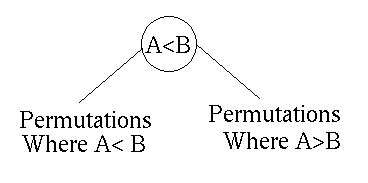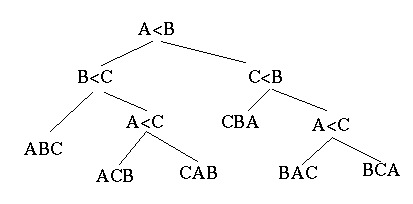A Lower Bound on Comparison Based Sorting
- We have seen three $O(n \log_2 n)$ sorts, so should we look for better.
- Perhaps, but that is for you to determine in homework 5.
- But should we expect asymptotically better?
- The following assumes:
- We are sorting a list of unique numbers.
- This is not unreasonable.
- And it just makes the following argument easier.
- A sort derives all information using a comparison operator.
- Given the first assumption == and != are out.
- In some sense >, >=, <, and <= are all the same.
- Each gives one piece of information.
- Sorting, in some real sense is finding the correct permutation of the input.
- For n items, there are $n!$ possible permutations.
- We need to model the decision to go from the input to the correct permutation.
- A decision tree lets us represent the work the sorting algorithm does
- Each internal node represents a comparison.
-

- Each leaf node represents one permutation of the input.
- As stated above, there will be at least $n!$ of these.
-

- A path from the root to a leaf represents the comparisons that need to be made to "sort" the data.
- Remember
- At level h, there are at most $2^h$ nodes in a binary tree.
- At level 0 there are $2^0$ = 1 node.
- At level 1 there are $2^2$ = 2 nodes.
- Then a tree with $2^h$ leaves must have high h.
- So the best decision tree we can build with $n!$ leaves must satisfy
$n! \le 2^h$
- or $h \ge \log_2 n!$
- A great Scotsman, James Sterling, provided a reasonably accurate approximation for $n!$, Sterling's approximation
- $n! \approx e^{-n}n^n\sqrt{2\pi n}$
- So $h \ge \log_2{(e^{-n}n^n\sqrt{2\pi n})}$
- Remember $\log(ab) = \log a + \log b$
- So $h \ge \log_2{e^{-n}} + \log_2{n^n} + \log_2{\sqrt{2\pi n}}$
- $h \ge -n\log_2{e} + n\log_2{n} + \frac{1}{2}\log_2{2\pi n}$
- Which means $h \in \Omega (n \log_2 n)$

